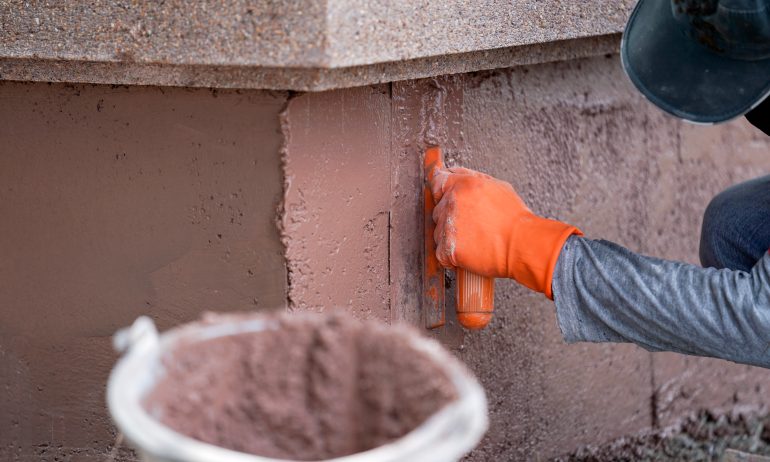Does Homeowners Insurance Cover Foundation Issues?

Many or all of the products featured here are from our partners who compensate us. This influences which products we write about and where and how the product appears on a page. However, this does not influence our evaluations. Our opinions are our own. Here is a list of our partners and here's how we make money.
Home insurance typically pays for foundation damage only if it’s caused by a sudden and accidental event that’s covered by the policy.
You’ll need separate coverage for damage that stems from flooding or an earthquake.
Damage that results from wear and tear, lack of maintenance or poor construction is rarely covered.
Your home’s foundation is the structural base that holds up the rest of the house. Without a sturdy foundation, the safety and integrity of your entire house is at risk. Your homeowners insurance will typically pay for some types of foundation damage, depending on the underlying cause. Here’s what you need to know.

Does homeowners insurance cover foundation issues?
Home insurance will generally pay for repairs to a home’s foundation if both of these conditions apply:
The damage was caused by an event covered by your policy. With an HO-3 policy, the most common type of home insurance, your insurer generally covers damage caused by perils that aren’t specifically excluded by the policy. HO-1 or HO-2 policies, which are less common, only cover damage caused by a peril named in the insurance contract.
The damage was sudden and accidental. If the foundation issue developed gradually or could have been avoided with proper home maintenance, your insurance company probably won’t cover it.
Your home’s foundation is insured by the dwelling coverage portion of your policy, also known as Coverage A. Dwelling coverage is the part of your policy that insures the home’s structure. It normally covers the house’s foundation, roof, frame, chimney, permanent fixtures and appliances, and attached structures, like a porch or garage.
When does home insurance typically cover foundation repair?
Standard homeowners insurance often covers foundation damage if it’s caused by one of the following events:
Fire or lightning.
Windstorm or hail.
Explosion.
Damage from a motor vehicle or an aircraft.
Vandalism.
Volcanic eruption.
A falling object, like a tree or power pole.
Weight of ice, snow or sleet.
Accidental water or steam discharge from a plumbing system, air conditioner or home appliance.
Note that figuring out what your home insurance policy covers isn’t always straightforward. For example, if a pipe suddenly burst in your home and damaged your home’s foundation, your insurance company would likely pay for repairs. But if the pipe had been leaking for a while and you didn’t repair it, your insurance company may refuse to pay for the resulting damage because it wasn’t sudden or accidental.
When home insurance typically won’t cover foundation damage
If the foundation damage wasn’t caused by a covered peril and didn’t stem from a sudden and accidental event, your homeowners policy probably won’t pay out. Here are some examples of foundation damage that standard home insurance policies typically wouldn’t cover.
It was caused by flooding or an earthquake. Most standard home insurance doesn’t protect you against floods or earthquakes, both of which are common causes of foundation damage. If you live in an area that’s vulnerable to these extreme weather events, you may need to buy additional flood insurance or earthquake insurance.
The issue is the result of normal wear and tear. Some foundation issues, like settling of the earth or small cracks, are normal and develop gradually. These problems are considered normal wear and tear and wouldn’t be covered by most home insurance.
Faulty construction is to blame. Insurers usually won’t cover damage due to poor construction, which is why it’s essential to have a thorough home inspection if you’re buying a house.
What causes foundation damage?
Foundation damage can have many underlying causes, including:
Water buildup and drainage issues. Excessive water that accumulates under the home’s foundation can wash away the underlying land, causing the foundation to move.
Natural disasters. Natural disasters like earthquakes, floods and wildfires can damage your home’s foundation.
Faulty construction. Uneven slabs, loose soil, concrete issues and shoddy building materials can all lead to foundation problems.
Pests. Burrowing animals (like hedgehogs and moles) and termites could compromise your foundation.
Prolonged drought. An extended dry period can cause the foundation to “settle” or gradually sink into the ground.
Tree roots. If a tree is planted too close to your home, it could cause foundation problems, particularly if it’s a tree with a shallow root system, like an oak or elm tree.
Many of these causes are preventable with proper home maintenance. For example, trimming tree roots, promptly fixing leaks and installing a solid drainage system can protect your home from developing foundation issues.
Does home insurance cover foundation cracks?
Foundation cracks usually aren’t covered by home insurance. The key words to remember are “sudden and accidental.” Cracks are a common early warning sign of foundational issues. Culprits can include water erosion, soil issues and faulty construction. All of these problems are usually addressed through basic home maintenance and repairs, which typically aren’t covered by home insurance.
How to file a claim for foundation repair
Before you file a claim for foundation damage, review your policy documents to confirm that the cause of the damage is covered. Also, look at your home insurance deductible. Your deductible is the amount you pay before insurance kicks in. For example, if your deductible is $1,000 and you have $10,000 worth of damage, you’d pay the first $1,000, while insurance would cover the remaining $9,000.
If the repair would cost less than the deductible, filing a claim usually won’t be worth it. A claim often makes your premiums go up because insurance companies use past claims to assess your likelihood of filing more claims in the future.
Don’t delay filing a claim if your home’s foundation is damaged due to a covered event. You may have a limited time frame for filing a claim, depending on your state. Take photos and videos to document the damage. When you contact your insurance company or agent, be prepared to provide a full explanation of the damage and how it occurred.
Warning signs of foundation damage
If you spot any signs of foundation damage, taking quick action is a must. Here are some warning signs to look out for:
Uneven floors.
Leaning walls.
Doors and windows that don’t open and close properly.
Cracks in doors, windows, the home’s exterior or basement walls.
Moisture in the basement or garage.
If you spot any of these warning signs, contact a building inspector immediately. While some signs of foundation damage will be easy to spot, some are less visible to the untrained eye. If you’re concerned that your home could develop foundation issues, it may be worth hiring a professional for regular inspections to catch any issues early before they become a costlier problem.
On a similar note...


